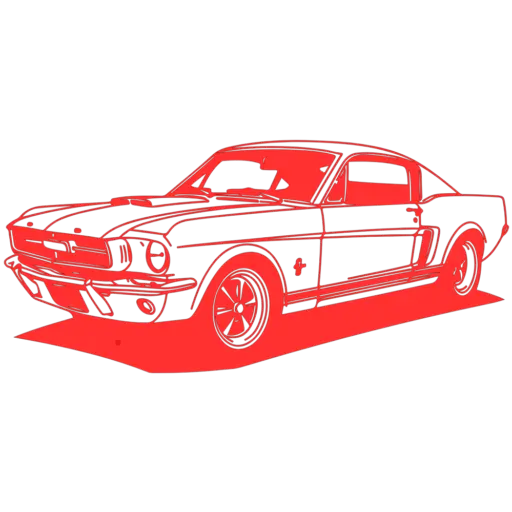In this article, I am going to tell you the story of the most iconic muscle cars of all time, those that not only defined an era, but remain a cult object for lovers of speed and pure mechanics.
If there is a type of car that It awakens passions, evokes nostalgia and makes the asphalt tremble., is the muscle car.
These are machines that not only shaped the history of motorsports, but also left their mark on popular culture, movies, street racing, and the minds of everyone who has heard their deafening roar.
But the muscle cars They weren't born out of nowhere. They emerged from an era where power was king, where cars weren't just made to move, but to dominate the road.
So sit back, imagine we're in a workshop surrounded by the smell of gasoline and hot metal, and we're going to talk about history, excitement, and V8 engines that made history.
The origins of muscle cars: when power became a lifestyle
The history of muscle cars begins in the 1960s in the United States, when automotive brands began to realize something: people wanted speed without spending a fortune on European sports cars.
Until then, powerful cars were large, expensive, and aimed at a more exclusive audience. But a group of visionary engineers and designers thought: "What if we took an affordable car, put a huge engine in it, and made it brutally fast?"
This is how the concept of muscle car:
✔ Large displacement engines (V8 most of the time).
✔ Relatively affordable and mass-produced car chassis.
✔ Aggressive and aerodynamic design.
✔ Built to go fast in a straight line and dominate drag racing.
And this is where the real story begins. Let's review the most iconic muscle cars and how they changed the history of motorsport.
Ford Mustang (1964): The Birth of a Legend
If we talk about muscle cars, The Mustang is the gateway for many enthusiasts.
When Ford launched it in 1964, it wasn't technically a muscle car, but rather a pony car (a similar but lighter category). However, when they introduced the GT350 and GT500 versions of the Shelby in 1965, the Mustang became a true power monster.
Why is it iconic?
- It was the car that started a revolution in the market.
- It was affordable, allowing thousands of young people to have access to a fast car.
- Carroll Shelby, the genius behind the GT350, turned it into a high-performance machine with 306 HP in its first version.
My experience with a classic Mustang:
I once had the opportunity to drive a 1967 Mustang FastbackThe sensation of turning the key and hearing the V8 come alive is something no modern car can replicate. It's a sound you don't just hear; it's a sound you feel in your chest.
Chevrolet Camaro (1967): GM's answer to Ford
It wasn't long before Chevrolet responded to the Mustang with its own monster: the Camaro.
Launched in 1967, the Camaro was Chevrolet's first attempt at competing in the muscle car segment, and it didn't disappoint. Especially with versions like the Z/28 and the powerful SS396, which took the Mustang-Camaro war to the next level.
Why is it iconic?
- Its more aggressive and muscular design made it stand out from the start.
- It was the basis for some of the most brutal versions, such as the 1969 COPO Camaro with its legendary 427 V8 engine.
- He became an icon of cinema and pop culture (did someone say Transformers?).
Dodge Charger (1968-1970): the muscle car that became a Hollywood star
If there is a car that represents the brutality and excess of muscle carss, is the Dodge Charger second generation (1968-1970).
This car became famous thanks to movies like Bullitt (with Steve McQueen chasing a black Charger through the streets of San Francisco) and The Fast and the Furious (yes, Dom Toretto's).
But beyond his fame on the big screen, The Charger was a muscle car with its own character.
Why is it iconic?
- Its long, wide, and aggressive design made it look like a predator on the road.
- He 1969 Charger R/T with 440 Magnum engine It delivered 375 HP from the factory.
- It was also available with the legendary Hemi 426 V8, an engine designed for NASCAR.
A curious fact:
He 1969 Dodge Charger Daytona, with its giant spoiler, was the first car in NASCAR history to exceed 200 miles per hour (322 km/h).
Plymouth Barracuda (1970-1971): the most extreme muscle car of the golden age
Plymouth, which was always in the shadow of Dodge, decided to throw a bomb at the market in 1970: the Barracuda Hemi 'Cuda.
This car was shorter, more aggressive and more powerful than most of its rivals, and with a 426 HEMI engine under the hood, could generate 425 HP from the factory.
Why is it iconic?
- It was one of the most powerful muscle cars ever made.
- Its design made it instantly stand out.
- Today, it is one of the most valuable and sought-after muscle cars, with prices exceeding one million dollars at auctions.
Muscle cars never died, they just evolved.
The muscle cars of the 1960s and 1970s were machines of excess. Giant engines, absurd gas mileage, but a pure, unfiltered driving experience.
Despite the oil crisis in the 70s and environmental regulations, lMuscle cars never disappeared. Today, models like the Dodge Challenger Hellcat, Ford Mustang GT, and Camaro ZL1 keep alive the essence of those golden years.
Muscle cars aren't just cars, they're an attitude, a story, and a statement of rebellion on wheels.
And if you ever get the chance to drive one of these classics, do it. Because there's nothing like the feeling of a V8 roaring under the hood, propelling you forward with brutal force, while the whole world becomes a blur in the rearview mirror.
And you, what's your favorite muscle car? Let me know in the comments!
+See also: How I started my vintage car collection

Passionate about classic cars for as long as he can remember, Javier Montoro has dedicated his life to the search, restoration, and preservation of true gems on wheels. With years of experience purchasing, restoring, and maintaining vintage vehicles, he shares his knowledge, stories, and lessons learned on this blog.

